Degradation of chlorinated hydrocarbons by natural mineral pyrite
Pyrite, an abundant natural mineral, has received a lot of attention due to its cause to
acidification of soil and groundwater in the presence of oxidants of which oxygen is the most
important. However, in the presence of oxygen, this research found an interesting ability of pyrite
toward degradation of chlorinated pollutants which have known resist in natural environment.
Laboratory batch experiments were conducted to investigate reactivity of pyrite aerobically
degrade chlorinated hydrocarbon at room temperature and pressure. Trichloroethylene (TCE) and
chlorobenzene (CB) were used as model compounds represented for aliphatic and aromatic
chlorinated hydrocarbons, respectively. Pyrite was showed effectively degrade both compounds
under the experimental condition. Degradation of these compounds was pseudo first order
reaction. Rate of degradation of TCE (ktce = 0.013h-1) was higher than of CB (kcb = 0.005 h-1).
These results showed the potential for application of pyrite in remediation of chlorinated
pollutants without the needs of any special condition such as high temperature or pressure which
normally need for other catalysts.
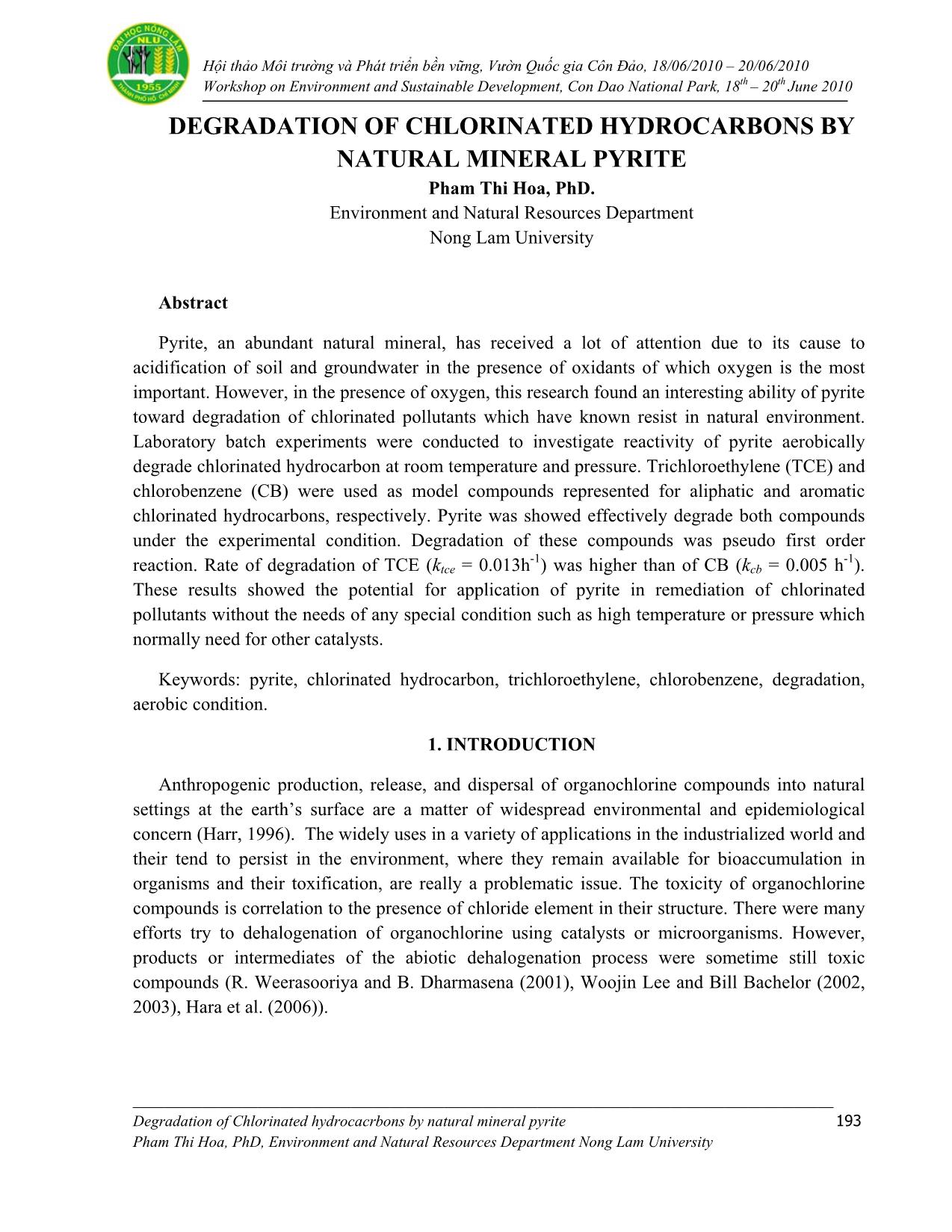
Trang 1
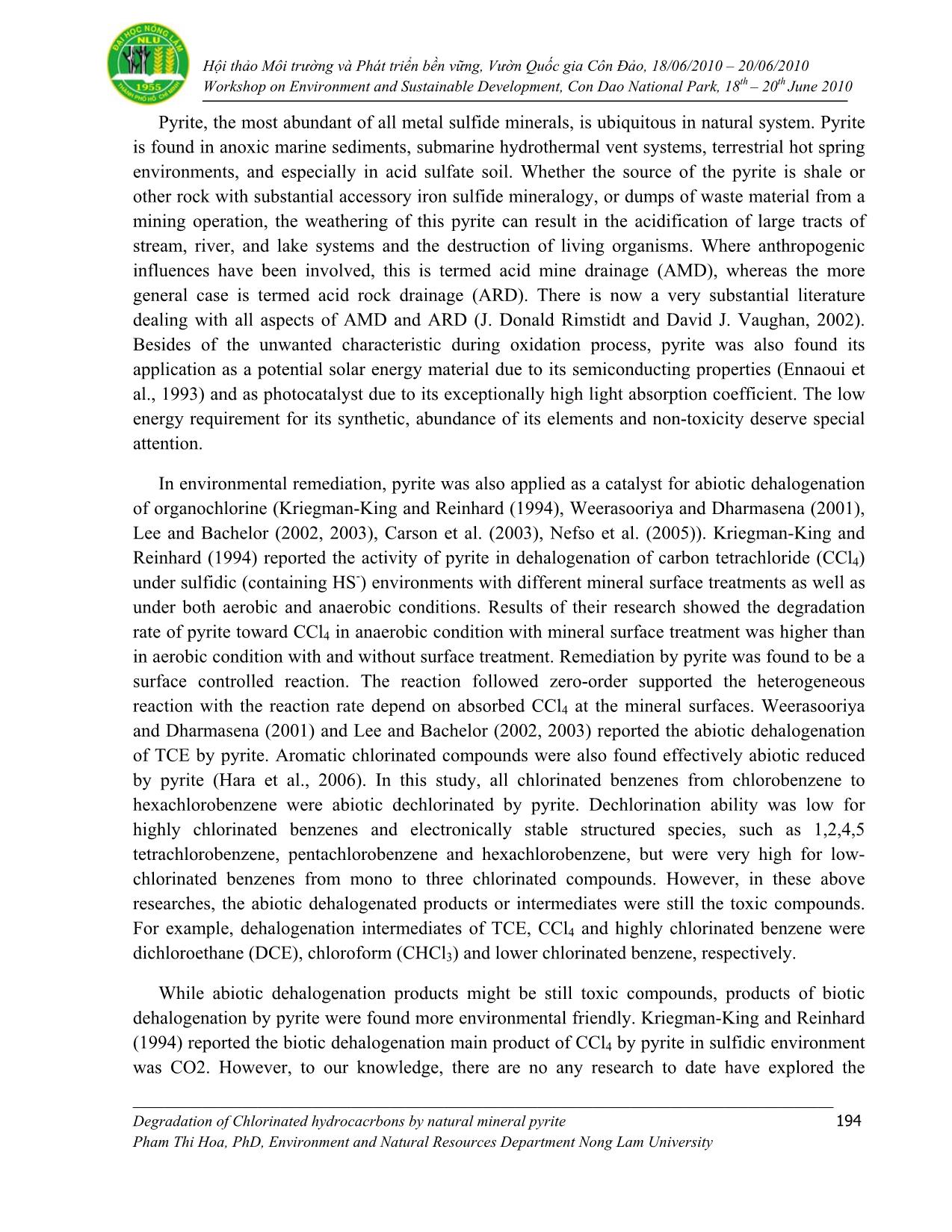
Trang 2
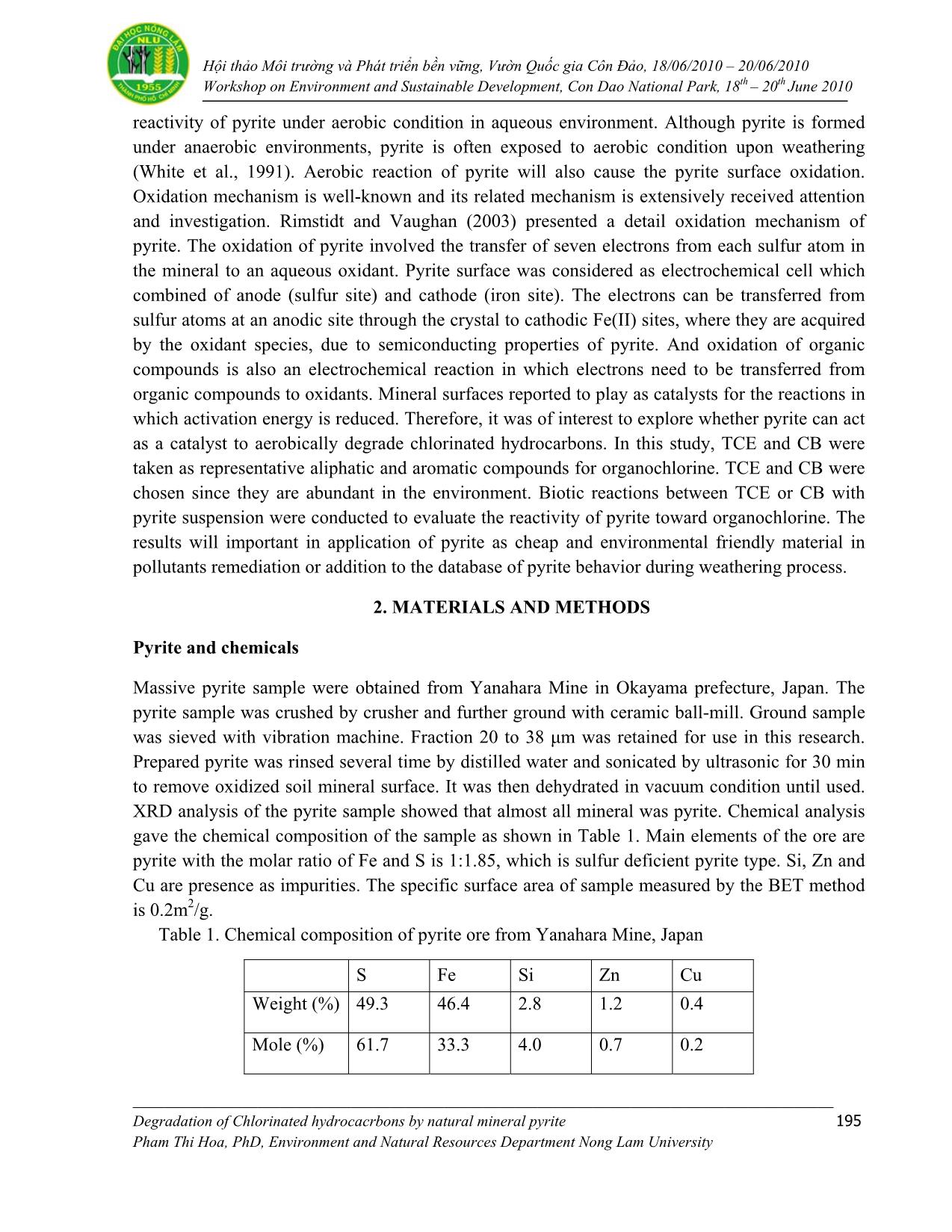
Trang 3
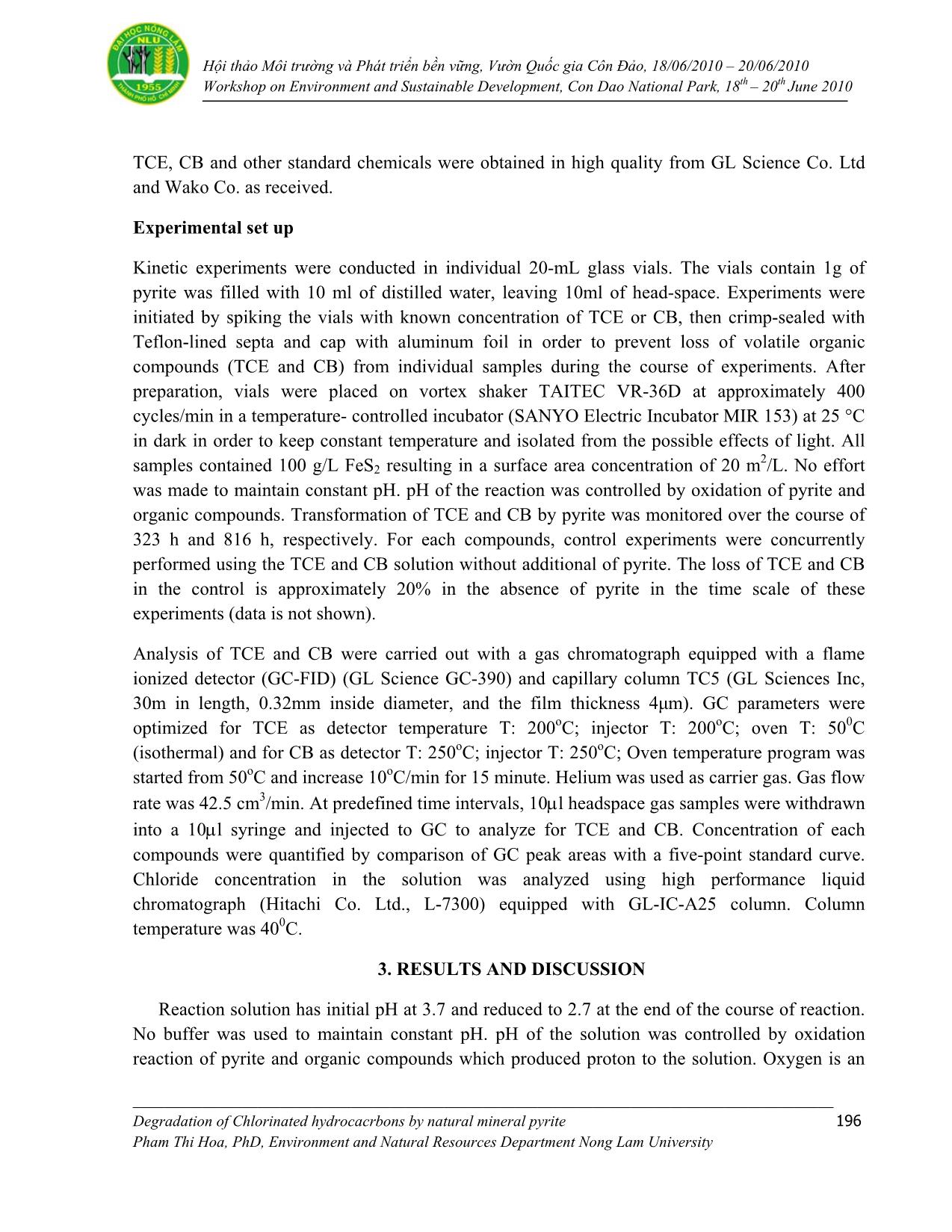
Trang 4
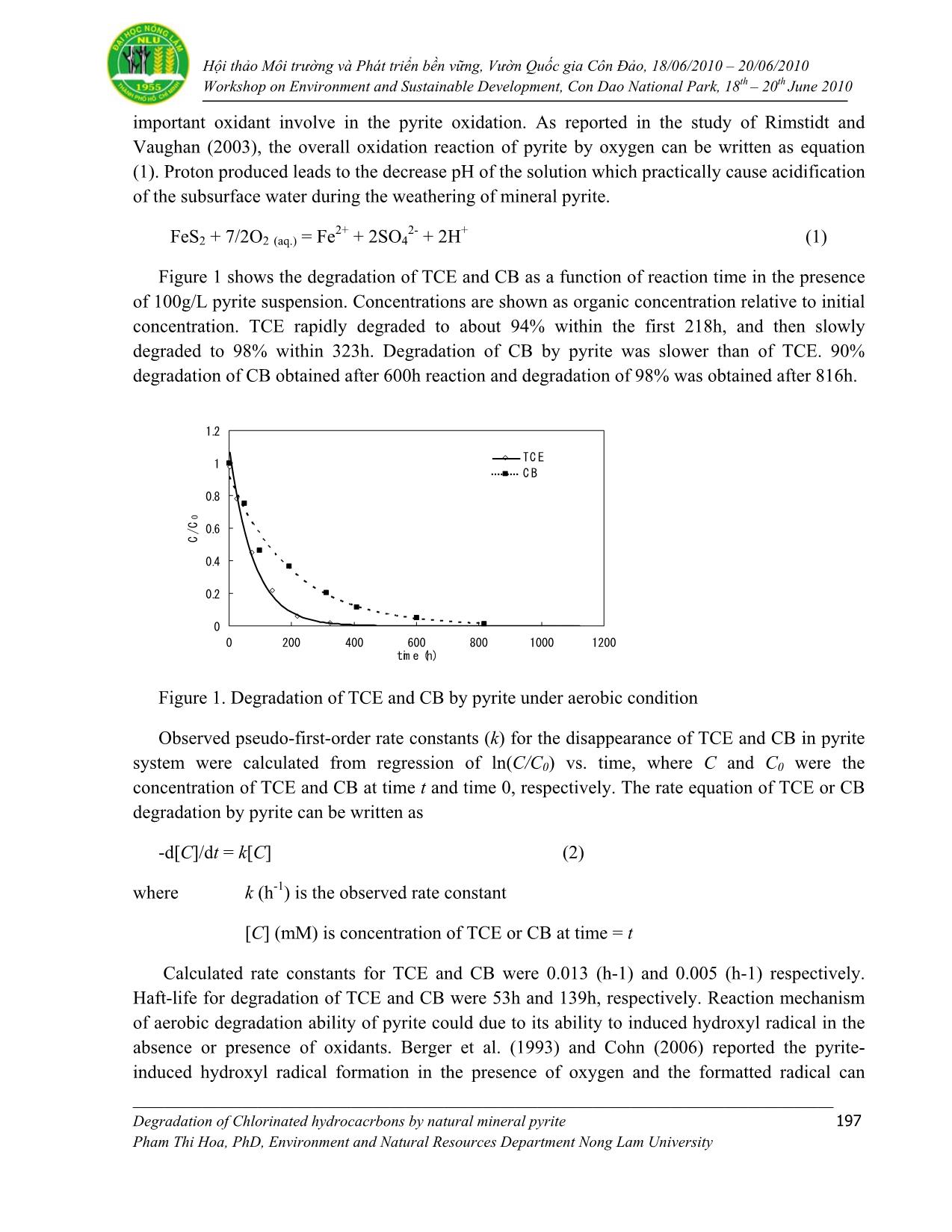
Trang 5
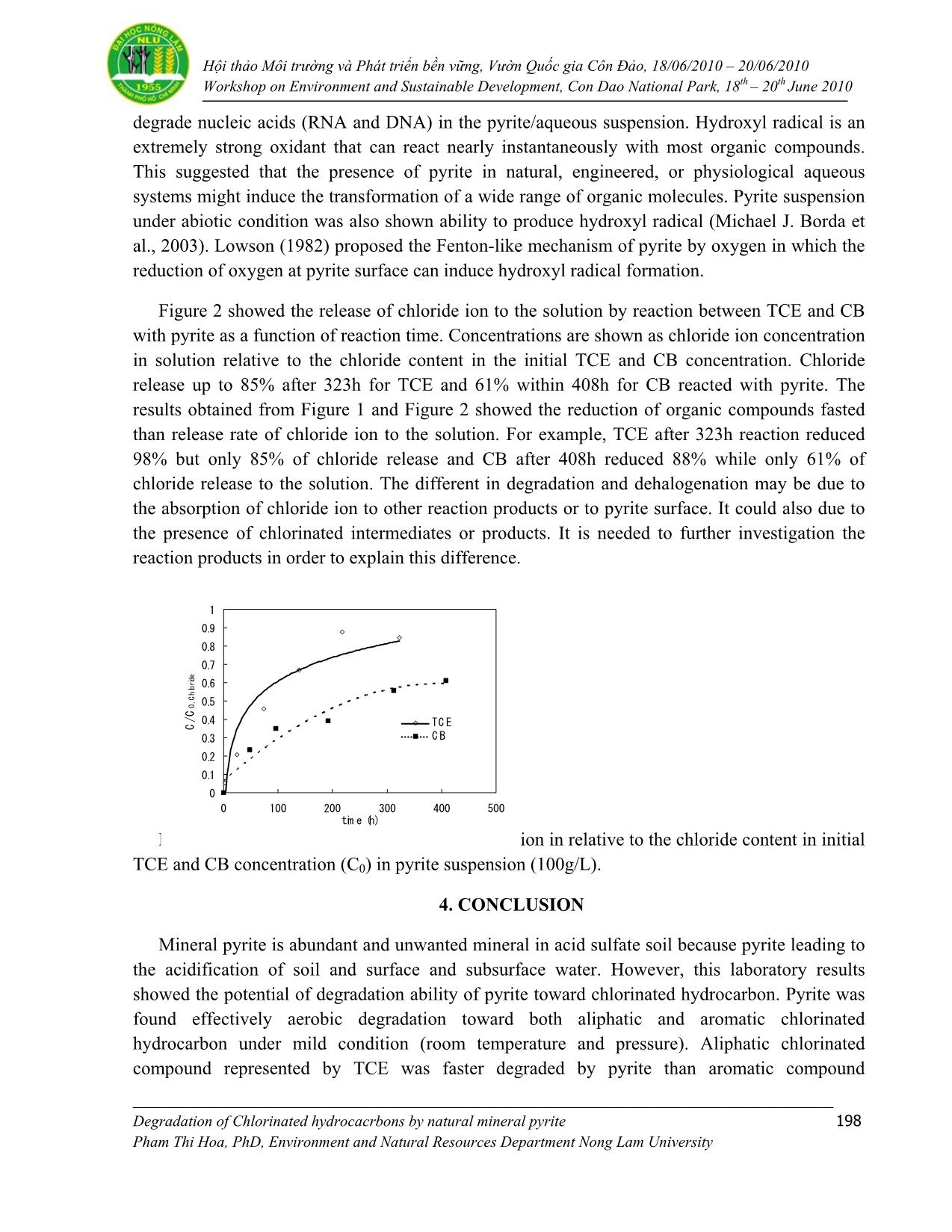
Trang 6
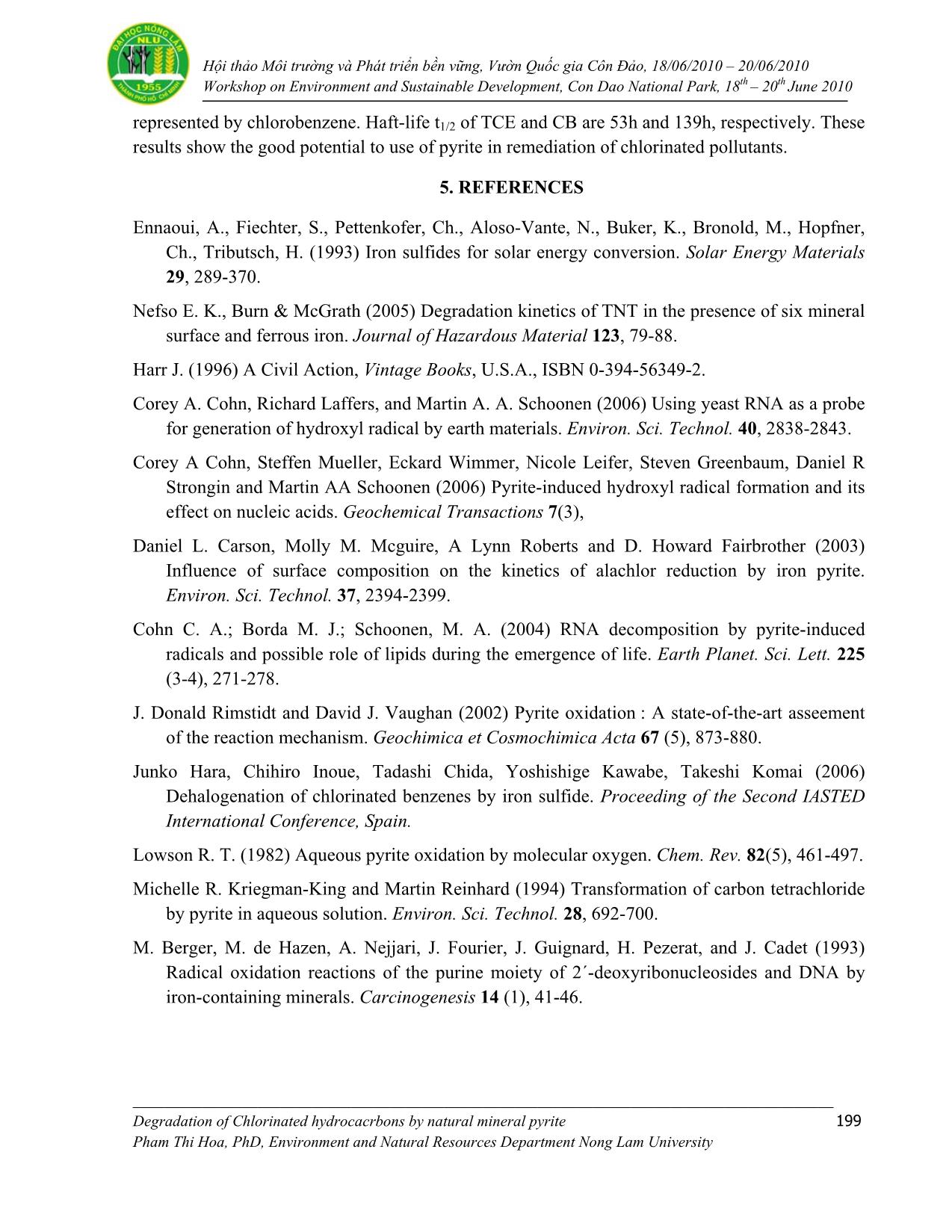
Trang 7
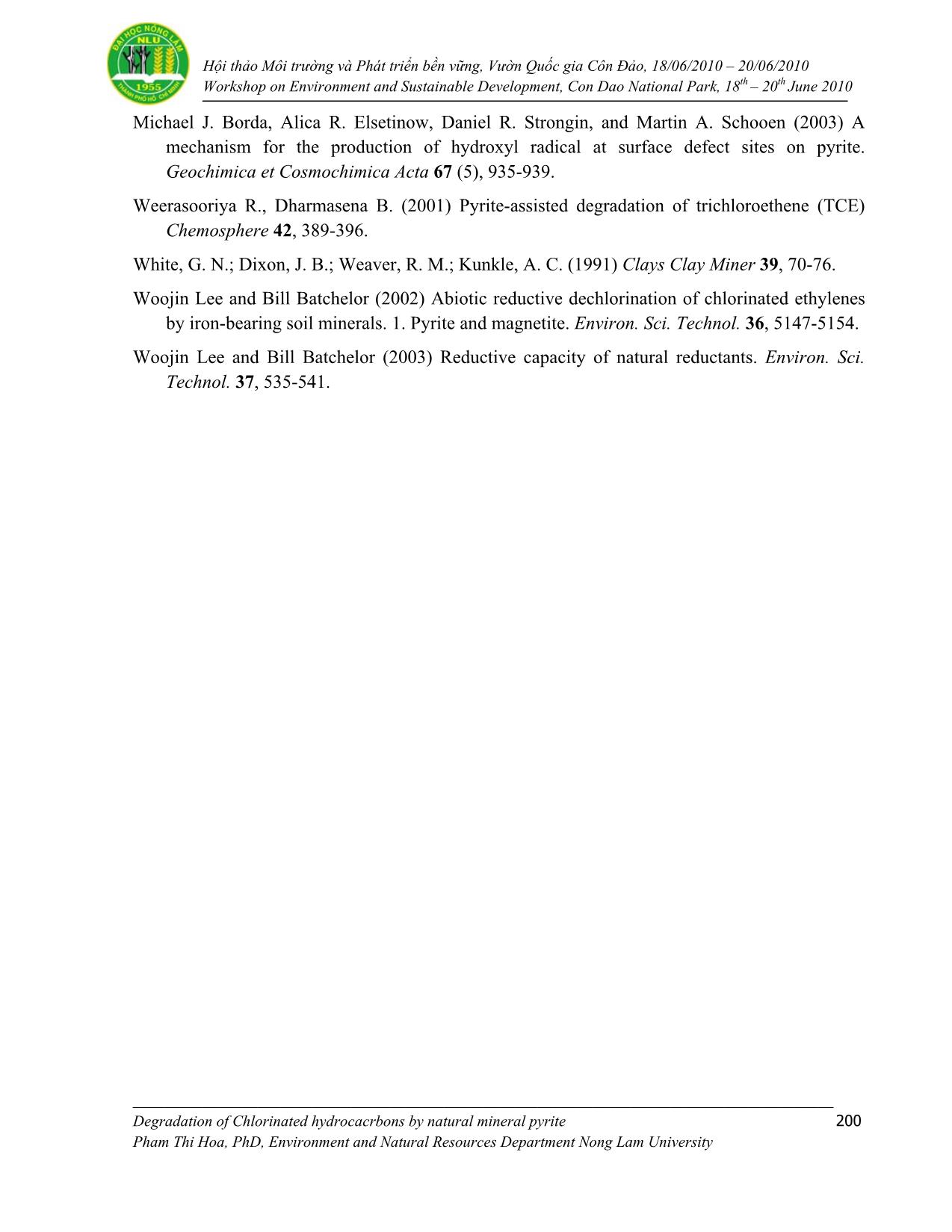
Trang 8

Trang 9
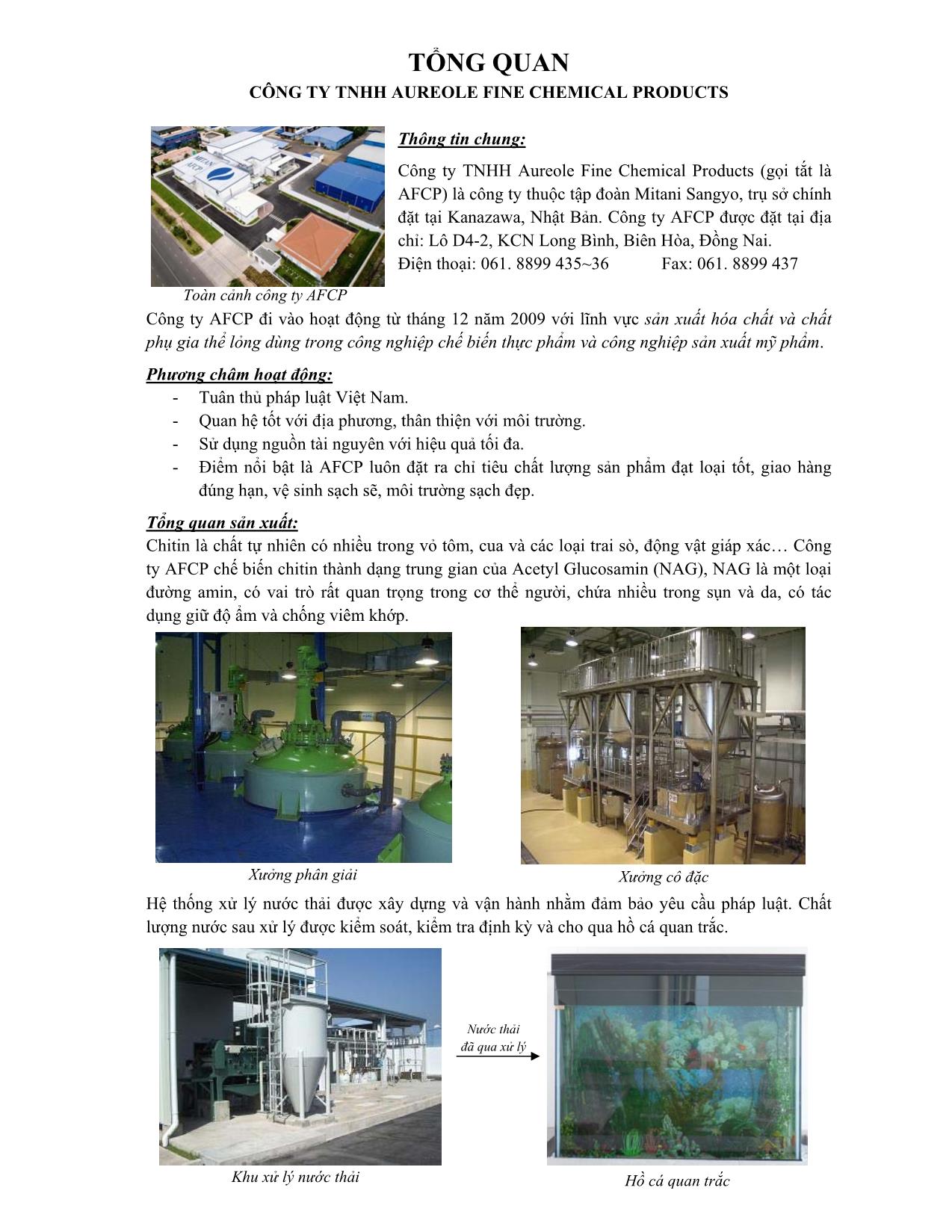
Trang 10
Tải về để xem bản đầy đủ
Tóm tắt nội dung tài liệu: Degradation of chlorinated hydrocarbons by natural mineral pyrite
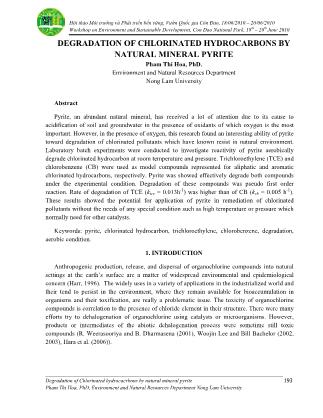
Hội thảo Môi trường và Phát triển bền vững, Vườn Quốc gia Côn Đảo, 18/06/2010 – 20/06/2010 Workshop on Environment and Sustainable Development, Con Dao National Park, 18th – 20th June 2010 __________________________________________________________________________________________ Degradation of Chlorinated hydrocacrbons by natural mineral pyrite 193 Pham Thi Hoa, PhD, Environment and Natural Resources Department Nong Lam University DEGRADATION OF CHLORINATED HYDROCARBONS BY NATURAL MINERAL PYRITE Pham Thi Hoa, PhD. Environment and Natural Resources Department Nong Lam University Abstract Pyrite, an abundant natural mineral, has received a lot of attention due to its cause to acidification of soil and groundwater in the presence of oxidants of which oxygen is the most important. However, in the presence of oxygen, this research found an interesting ability of pyrite toward degradation of chlorinated pollutants which have known resist in natural environment. Laboratory batch experiments were conducted to investigate reactivity of pyrite aerobically degrade chlorinated hydrocarbon at room temperature and pressure. Trichloroethylene (TCE) and chlorobenzene (CB) were used as model compounds represented for aliphatic and aromatic chlorinated hydrocarbons, respectively. Pyrite was showed effectively degrade both compounds under the experimental condition. Degradation of these compounds was pseudo first order reaction. Rate of degradation of TCE (ktce = 0.013h-1) was higher than of CB (kcb = 0.005 h-1). These results showed the potential for application of pyrite in remediation of chlorinated pollutants without the needs of any special condition such as high temperature or pressure which normally need for other catalysts. Keywords: pyrite, chlorinated hydrocarbon, trichloroethylene, chlorobenzene, degradation, aerobic condition. 1. INTRODUCTION Anthropogenic production, release, and dispersal of organochlorine compounds into natural settings at the earth’s surface are a matter of widespread environmental and epidemiological concern (Harr, 1996). The widely uses in a variety of applications in the industrialized world and their tend to persist in the environment, where they remain available for bioaccumulation in organisms and their toxification, are really a problematic issue. The toxicity of organochlorine compounds is correlation to the presence of chloride element in their structure. There were many efforts try to dehalogenation of organochlorine using catalysts or microorganisms. However, products or intermediates of the abiotic dehalogenation process were sometime still toxic compounds (R. Weerasooriya and B. Dharmasena (2001), Woojin Lee and Bill Bachelor (2002, 2003), Hara et al. (2006)). Hội thảo Môi trường và Phát triển bền vững, Vườn Quốc gia Côn Đảo, 18/06/2010 – 20/06/2010 Workshop on Environment and Sustainable Development, Con Dao National Park, 18th – 20th June 2010 __________________________________________________________________________________________ Degradation of Chlorinated hydrocacrbons by natural mineral pyrite 194 Pham Thi Hoa, PhD, Environment and Natural Resources Department Nong Lam University Pyrite, the most abundant of all metal sulfide minerals, is ubiquitous in natural system. Pyrite is found in anoxic marine sediments, submarine hydrothermal vent systems, terrestrial hot spring environments, and especially in acid sulfate soil. Whether the source of the pyrite is shale or other rock with substantial accessory iron sulfide mineralogy, or dumps of waste material from a mining operation, the weathering of this pyrite can result in the acidification of large tracts of stream, river, and lake systems and the destruction of living organisms. Where anthropogenic influences have been involved, this is termed acid mine drainage (AMD), whereas the more general case is termed acid rock drainage (ARD). There is now a very substantial literature dealing with all aspects of AMD and ARD (J. Donald Rimstidt and David J. Vaughan, 2002). Besides of the unwanted characteristic during oxidation process, pyrite was also found its application as a potential solar energy material due to its semiconducting properties (Ennaoui et al., 1993) and as photocatalyst due to its exceptionally high light absorption coefficient. The low energy requirement for its synthetic, abundance of its elements and non-toxicity deserve special attention. In environmental remediation, pyrite was also applied as a catalyst for abiotic dehalogenation of organochlorine (Kriegman-King and Reinhard (1994), Weerasooriya and Dharmasena (2001), Lee and Bachelor (2002, 2003), Carson et al. (2003), Nefso et al. (2005)). Kriegman-King and Reinhard (1994) reported the activity of pyrite in dehalogenation of carbon tetrachloride (CCl4) under sulfidic (containing HS-) environments with different mineral surface treatments a ... Berger et al. (1993) and Cohn (2006) reported the pyrite- induced hydroxyl radical formation in the presence of oxygen and the formatted radical can 0 0.2 0.4 0.6 0.8 1 1.2 0 200 400 600 800 1000 1200 tim e (h) C /C 0 TC E C B Expon. (C B) Expon. (TC E) Hội thảo Môi trường và Phát triển bền vững, Vườn Quốc gia Côn Đảo, 18/06/2010 – 20/06/2010 Workshop on Environment and Sustainable Development, Con Dao National Park, 18th – 20th June 2010 __________________________________________________________________________________________ Degradation of Chlorinated hydrocacrbons by natural mineral pyrite 198 Pham Thi Hoa, PhD, Environment and Natural Resources Department Nong Lam University degrade nucleic acids (RNA and DNA) in the pyrite/aqueous suspension. Hydroxyl radical is an extremely strong oxidant that can react nearly instantaneously with most organic compounds. This suggested that the presence of pyrite in natural, engineered, or physiological aqueous systems might induce the transformation of a wide range of organic molecules. Pyrite suspension under abiotic condition was also shown ability to produce hydroxyl radical (Michael J. Borda et al., 2003). Lowson (1982) proposed the Fenton-like mechanism of pyrite by oxygen in which the reduction of oxygen at pyrite surface can induce hydroxyl radical formation. Figure 2 showed the release of chloride ion to the solution by reaction between TCE and CB with pyrite as a function of reaction time. Concentrations are shown as chloride ion concentration in solution relative to the chloride content in the initial TCE and CB concentration. Chloride release up to 85% after 323h for TCE and 61% within 408h for CB reacted with pyrite. The results obtained from Figure 1 and Figure 2 showed the reduction of organic compounds fasted than release rate of chloride ion to the solution. For example, TCE after 323h reaction reduced 98% but only 85% of chloride release and CB after 408h reduced 88% while only 61% of chloride release to the solution. The different in degradation and dehalogenation may be due to the absorption of chloride ion to other reaction products or to pyrite surface. It could also due to the presence of chlorinated intermediates or products. It is needed to further investigation the reaction products in order to explain this difference. Figure 2. The release of chloride ion to the solution in relative to the chloride content in initial TCE and CB concentration (C0) in pyrite suspension (100g/L). 4. CONCLUSION Mineral pyrite is abundant and unwanted mineral in acid sulfate soil because pyrite leading to the acidification of soil and surface and subsurface water. However, this laboratory results showed the potential of degradation ability of pyrite toward chlorinated hydrocarbon. Pyrite was found effectively aerobic degradation toward both aliphatic and aromatic chlorinated hydrocarbon under mild condition (room temperature and pressure). Aliphatic chlorinated compound represented by TCE was faster degraded by pyrite than aromatic compound 0 0.1 0.2 0.3 0.4 0.5 0.6 0.7 0.8 0.9 1 0 100 200 300 400 500 tim e (h) C /C 0, C hl or ide TC E C B Poly. (C B) Log. (TC E) Hội thảo Môi trường và Phát triển bền vững, Vườn Quốc gia Côn Đảo, 18/06/2010 – 20/06/2010 Workshop on Environment and Sustainable Development, Con Dao National Park, 18th – 20th June 2010 __________________________________________________________________________________________ Degradation of Chlorinated hydrocacrbons by natural mineral pyrite 199 Pham Thi Hoa, PhD, Environment and Natural Resources Department Nong Lam University represented by chlorobenzene. Haft-life t1/2 of TCE and CB are 53h and 139h, respectively. These results show the good potential to use of pyrite in remediation of chlorinated pollutants. 5. REFERENCES Ennaoui, A., Fiechter, S., Pettenkofer, Ch., Aloso-Vante, N., Buker, K., Bronold, M., Hopfner, Ch., Tributsch, H. (1993) Iron sulfides for solar energy conversion. Solar Energy Materials 29, 289-370. Nefso E. K., Burn & McGrath (2005) Degradation kinetics of TNT in the presence of six mineral surface and ferrous iron. Journal of Hazardous Material 123, 79-88. Harr J. (1996) A Civil Action, Vintage Books, U.S.A., ISBN 0-394-56349-2. Corey A. Cohn, Richard Laffers, and Martin A. A. Schoonen (2006) Using yeast RNA as a probe for generation of hydroxyl radical by earth materials. Environ. Sci. Technol. 40, 2838-2843. Corey A Cohn, Steffen Mueller, Eckard Wimmer, Nicole Leifer, Steven Greenbaum, Daniel R Strongin and Martin AA Schoonen (2006) Pyrite-induced hydroxyl radical formation and its effect on nucleic acids. Geochemical Transactions 7(3), Daniel L. Carson, Molly M. Mcguire, A Lynn Roberts and D. Howard Fairbrother (2003) Influence of surface composition on the kinetics of alachlor reduction by iron pyrite. Environ. Sci. Technol. 37, 2394-2399. Cohn C. A.; Borda M. J.; Schoonen, M. A. (2004) RNA decomposition by pyrite-induced radicals and possible role of lipids during the emergence of life. Earth Planet. Sci. Lett. 225 (3-4), 271-278. J. Donald Rimstidt and David J. Vaughan (2002) Pyrite oxidation : A state-of-the-art asseement of the reaction mechanism. Geochimica et Cosmochimica Acta 67 (5), 873-880. Junko Hara, Chihiro Inoue, Tadashi Chida, Yoshishige Kawabe, Takeshi Komai (2006) Dehalogenation of chlorinated benzenes by iron sulfide. Proceeding of the Second IASTED International Conference, Spain. Lowson R. T. (1982) Aqueous pyrite oxidation by molecular oxygen. Chem. Rev. 82(5), 461-497. Michelle R. Kriegman-King and Martin Reinhard (1994) Transformation of carbon tetrachloride by pyrite in aqueous solution. Environ. Sci. Technol. 28, 692-700. M. Berger, M. de Hazen, A. Nejjari, J. Fourier, J. Guignard, H. Pezerat, and J. Cadet (1993) Radical oxidation reactions of the purine moiety of 2´-deoxyribonucleosides and DNA by iron-containing minerals. Carcinogenesis 14 (1), 41-46. Hội thảo Môi trường và Phát triển bền vững, Vườn Quốc gia Côn Đảo, 18/06/2010 – 20/06/2010 Workshop on Environment and Sustainable Development, Con Dao National Park, 18th – 20th June 2010 __________________________________________________________________________________________ Degradation of Chlorinated hydrocacrbons by natural mineral pyrite 200 Pham Thi Hoa, PhD, Environment and Natural Resources Department Nong Lam University Michael J. Borda, Alica R. Elsetinow, Daniel R. Strongin, and Martin A. Schooen (2003) A mechanism for the production of hydroxyl radical at surface defect sites on pyrite. Geochimica et Cosmochimica Acta 67 (5), 935-939. Weerasooriya R., Dharmasena B. (2001) Pyrite-assisted degradation of trichloroethene (TCE) Chemosphere 42, 389-396. White, G. N.; Dixon, J. B.; Weaver, R. M.; Kunkle, A. C. (1991) Clays Clay Miner 39, 70-76. Woojin Lee and Bill Batchelor (2002) Abiotic reductive dechlorination of chlorinated ethylenes by iron-bearing soil minerals. 1. Pyrite and magnetite. Environ. Sci. Technol. 36, 5147-5154. Woojin Lee and Bill Batchelor (2003) Reductive capacity of natural reductants. Environ. Sci. Technol. 37, 535-541. CÁC ĐƠN VỊ TÀI TRỢ TỔNG QUAN CÔNG TY TNHH AUREOLE FINE CHEMICAL PRODUCTS Thông tin chung: Công ty TNHH Aureole Fine Chemical Products (gọi tắt là AFCP) là công ty thuộc tập đoàn Mitani Sangyo, trụ sở chính đặt tại Kanazawa, Nhật Bản. Công ty AFCP được đặt tại địa chỉ: Lô D4-2, KCN Long Bình, Biên Hòa, Đồng Nai. Điện thoại: 061. 8899 435~36 Fax: 061. 8899 437 Công ty AFCP đi vào hoạt động từ tháng 12 năm 2009 với lĩnh vực sản xuất hóa chất và chất phụ gia thể lỏng dùng trong công nghiệp chế biến thực phẩm và công nghiệp sản xuất mỹ phẩm. Phương châm hoạt động: - Tuân thủ pháp luật Việt Nam. - Quan hệ tốt với địa phương, thân thiện với môi trường. - Sử dụng nguồn tài nguyên với hiệu quả tối đa. - Điểm nổi bật là AFCP luôn đặt ra chỉ tiêu chất lượng sản phẩm đạt loại tốt, giao hàng đúng hạn, vệ sinh sạch sẽ, môi trường sạch đẹp. Tổng quan sản xuất: Chitin là chất tự nhiên có nhiều trong vỏ tôm, cua và các loại trai sò, động vật giáp xác Công ty AFCP chế biến chitin thành dạng trung gian của Acetyl Glucosamin (NAG), NAG là một loại đường amin, có vai trò rất quan trọng trong cơ thể người, chứa nhiều trong sụn và da, có tác dụng giữ độ ẩm và chống viêm khớp. Hệ thống xử lý nước thải được xây dựng và vận hành nhằm đảm bảo yêu cầu pháp luật. Chất lượng nước sau xử lý được kiểm soát, kiểm tra định kỳ và cho qua hồ cá quan trắc. Xưởng phân giải Xưởng cô đặc Khu xử lý nước thải Hồ cá quan trắc Nước thải đã qua xử lý Toàn cảnh công ty AFCP ĐỀ TÀI Nghiên cứu phát triển rừng Tràm Trà Sư thành khu Du Lịch Sinh Thái ĐỀ TÀI Khảo sát tài nguyên sinh học ở các tỉnh đồng bằng sông Cửu Long BỘ MÔN MÔI TRƯỜNG I. GIỚI THIỆU Việc phát triển vũ bão của nền kinh tế trên thế giới cũng như ở Việt Nam đã tạo ra nhu cầu ưu tiên đào tạo đội ngũ những người có khả năng kết hợp hài hòa việc bảo vệ môi trường - tài nguyên và phát triển kinh tế. Bộ môn Môi Trường được ra đời vào tháng 11 năm 2009 có chức năng thực hiện các hoạt động đào tạo đội ngũ có chất lượng quản lý công nghệ môi trường, nghiên cứu khoa học và công nghệ, tổ chức học thuật và tham gia hoạt động ứng dụng khoa học kỹ thuật, dịch vụ kỹ thuật trong lĩnh vực môi trường. II. NHIỆM VỤ Đảm nhận tổ chức đào tạo trình độ đại học ngành Quản lý Công nghệ Môi trường với đầy đủ giá trị cốt lõi của Đại học Hoa Sen là Hiếu học, Hiếu tri, Tư duy độc lập, Tinh thần trách nhiệm, Chính trực, Năng động, sáng tạo, Cam kết hướng đến chất lượng cao nhất và Tôn trọng sự khác biệt, đa dạng. -- III. HƯỚNG NGHIÊN CỨU & ĐÀO TẠO - Kiến thức cơ bản của các ngành học liên quan trực tiếp đến môi trường như hoá học, sinh học, sinh thái học. - Tổng hợp các kiến thức để thấy được mối quan hệ tổng hoà của các ngành học trong ngành khoa học môi trường cũng như sự phụ thuộc lẫn nhau trong mối quan hệ tổng hoà này. - Nguyên lý và thực hành của công nghệ và quản lý môi trường - Phương pháp tổng quát cũng như đặc thù trong nghiên cứu môi trường hiện đại - Các ảnh hưởng của hoạt động kinh tế đến môi trường và của môi trường đến phát triển và sức khỏe con người - Kiến thức về các phương pháp và công cụ quản lý dự án môi trường tiên tiến. - Công nghệ và quản lý môi trường trong khu công nghiệp, trong cộng đồng xã hội và trong điều kiện cạnh tranh toàn cầu. - Pháp lý về môi trường, tiêu chuẩn môi trường tại Việt Nam và trên thế giới. IV. CÁN BỘ GIẢNG DẠY NGÀNH QUẢN LÝ CÔNG NGHỆ MÔI TRƯỜNG Tham gia giảng dạy ngành Quản lý công nghệ môi trường có: 1 Giáo sư, 4 Phó giáo sư, 13 Tiến sỹ cùng nhiều thạc sỹ được đào tạo trong nước và nước ngoài như Thái Lan, Nhật Bản, Hàn Quốc, Anh, Thụy Điển, Nga, Pháp, Úc, Hoa Kỳ, Canada (xem chương trình đào tạo ngành Quản lý công nghệ môi trường) Trưởng bộ môn: PGS. TS. Bùi Xuân An (bxan@hoasen.edu.vn) Taïi Vuõng Taøu: 422 Leâ Hoàng Phong, Phöôøng Thaéng Tam, Tp. Vuõng Taøu Ñieän thoaïi 064.3858792 - Fax: 064.3523698 Taïi Coân Ñaûo: 29 Voõ Thò Saùu, Huyeän Coân Ñaûo,Tænh Baø Ròa Vuõng Taøu Ñieän thoaïi: 064.3830150, Fax: 064.3830493 Website:www.condaopark.com.vn; Email: @condaopark.com.vn VƯỜN QUỐC GIA CÔN ĐẢO GIỚI THIỆU 1. Sơ lược Vườn quốc gia (VQG) Côn Đảo, tỉnh Bà Rịa – Vũng Tàu được thành lập vào ngày 31/03/1993 theo Quyết định số 135/TTg của Thủ tướng CP trên cơ sở chuyển hạng từ Rừng cấm Côn Đảo được Hội Đồng Bộ Trưởng thành lập năm 1984. VQG Côn Đảo có quy mô diện tích hiện nay là 19.990,7ha, bao gồm: - Diện tích rừng núi: 5.990,7 ha (của 14 đảo). - Diện tích trên biển 14.000 ha. Ngoài ra, một hành lang đệm trên biển có diện tích 20.500ha. 2. Nhiệm vụ, chức năng - Bảo tồn và phục hồi các hệ sinh thái rừng, hệ sinh thái biển, sự đa dạng sinh học và các loài động vật, thực vật bản địa, quý hiếm, các sinh cảnh tự nhiên độc đáo của Côn Đảo để Vườn quốc gia Côn Đảo trở thành một trung tâm bảo tồn đa dạng sinh học có tầm quan trọng của quốc gia và quốc tế. - Bảo vệ nguyên vẹn và phát triển diện tích rừng để gia tăng độ che phủ rừng đầu nguồn các khe, suối, bảo vệ đất, góp phần duy trì sự sống trên đảo, cung cấp nguồn nước ngọt cho sinh hoạt và phát triển kinh tế, đồng thời bảo vệ rừng nhằm góp phần củng cố quốc phòng và an ninh vùng hải đảo tiền tiêu phía Đông Nam tổ quốc. - Sử dụng hợp lý tài nguyên đa dạng sinh học và các dịch vụ môi trường rừng để phát triển du lịch sinh thái, góp phần xây dựng Côn Đảo trở thành một trung tâm du lịch-dịch vụ chất lượng cao, có tầm cỡ khu vực và quốc tế và tạo cơ sở cho sự phát triển bền vững về kinh tế và xã hội của huyện Côn Đảo. Vườn Quốc gia Côn Đảo - nơi còn tồn tại các hệ sinh thái tự nhiên của rừng, biển rất đa dạng, phong phú và hầu như còn nguyên vẹn; tính đa dạng sinh học cao với nhiều loài động thực vật quý hiếm và đặc hữu có ý nghĩa tầm quốc gia và toàn cầu. Chính vì vậy, chúng ta cần phải trân trọng, giữ gìn và bảo tồn thật tốt những tài nguyên vô giá đó. TÀI NGUYÊN ĐA DẠNG SINH HỌC Đa dạng sinh học của Vườn quốc gia Côn Đảo được các chuyên gia khoa học trong và ngoài nước đánh giá cao. Rừng Côn Đảo có 1.077 loài thực vật bậc cao, có mạch và 160 loài động vật trong đó có 44 loài thực vật được phát hiện đầu tiên ở Côn Đảo, có 11 loài thực vật mang tên Côn Sơn. Có 31 loài động vật quý hiếm như bồ câu Nicoba, chim Điên bụng trắng, Sóc đen Côn Đảo, v.v... Biển Côn Đảo có các hệ sinh thái (HST): HST rừng ngập mặn, HST cỏ biển, HST rạn san hô, các HST này là nơi ương nuôi và phát tán nguồn giống các loài thủy sản cho vùng biển phía Đông – Nam của Tổ Quốc và khu vực Đông – Nam Á. Có hơn 1.493 loài sinh vật biển được ghi nhận tại Côn Đảo trong có các loài quý, hiếm đang có nguy cơ tuyệt chủng trên toàn cầu như các loài Rùa biển, Dugong, Cá heo, Trai tai tượng v.v... Vườn quốc gia Côn Đảo có cảnh quan thiên nhiên đẹp, hoang sơ, môi trường trong lành. Đa dạng sinh học tại Côn Đảo và cảnh quan thiên nhiên là tiềm năng và thế mạnh để Côn Đảo phát triển các loại hình du lịch sinh thái chất lượng cao. DU LỊCH SINIH THÁI Dự án phát triển du lịch sinh thái ở Vườn Quốc Gia Côn Đảo đã được UBND tỉnh Bà Rịa – Vũng Tàu phê duyệt theo quyết định 985/ QĐ.UB ngày 12 tháng 3 năm 2000. 1. Các loại hình du lịch sinh thái - Du lịch nghỉ ngơi, tịnh dưỡng, ngắm cảnh, thư giản - Du lịch thể thao: Câu cá, leo núi, lặn, đi bộ, đi xe đạp, bơi lội, tắm biển - Du lịch kết hợp nghiên cứu khoa học 2. Các sản phẩm du lịch sinh thái : Có 5 điểm và 9 tuyến du lich sinh thái cho du khách bao gồm các hoạt động như: - Xem Rùa biển để trứng, xem cua Xe tăng, tham quan rừng,... - Xem San hô bằng tàu đáy kính - Bơi có ống thở hoặc lặn có bình dưỡng khí khám phá đại dương hải đảo.
File đính kèm:
 degradation_of_chlorinated_hydrocarbons_by_natural_mineral_p.pdf
degradation_of_chlorinated_hydrocarbons_by_natural_mineral_p.pdf

